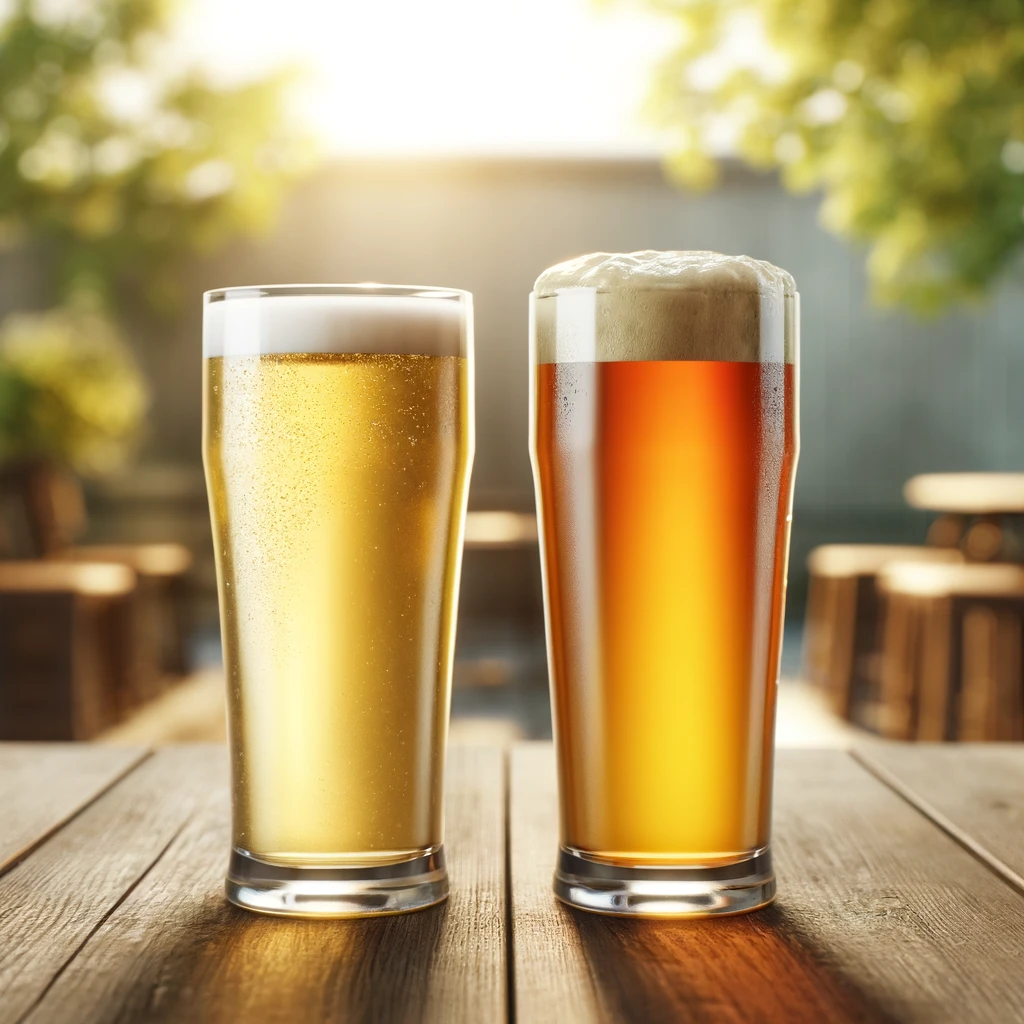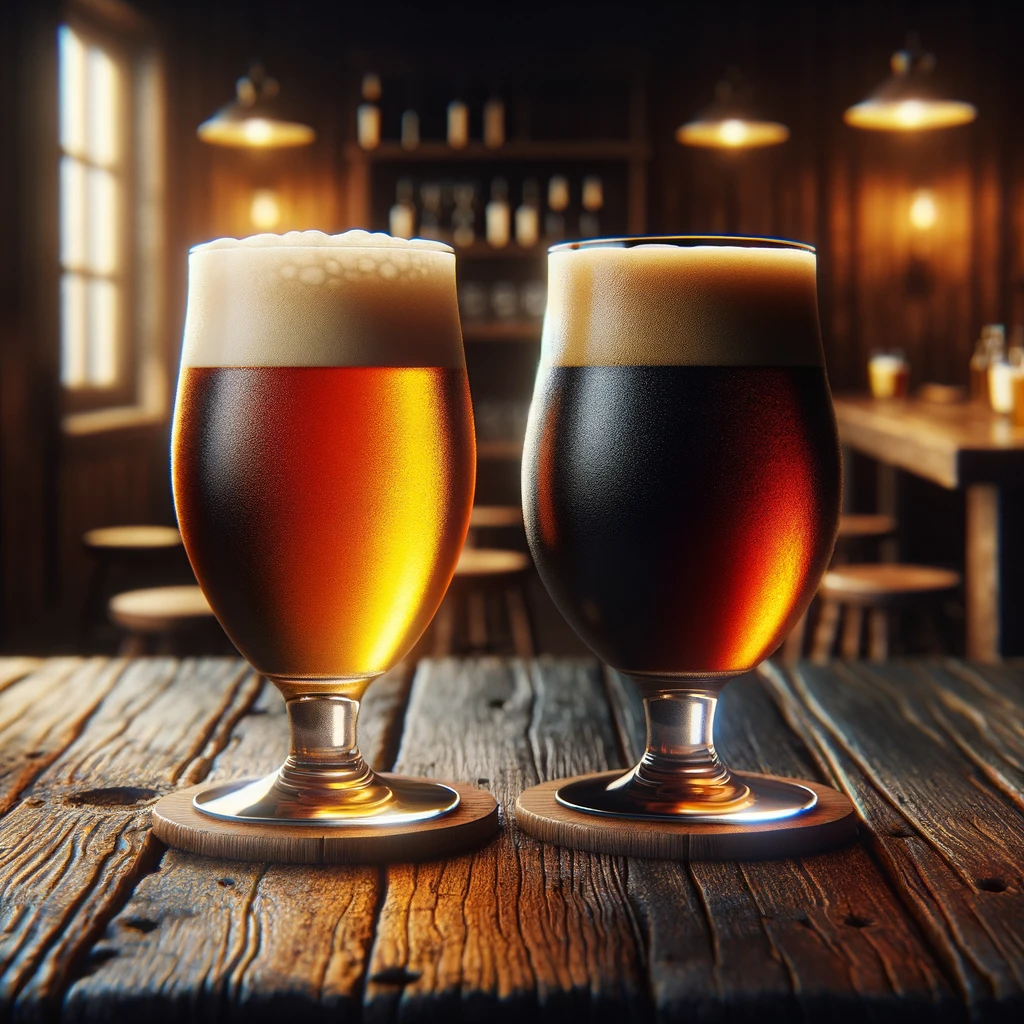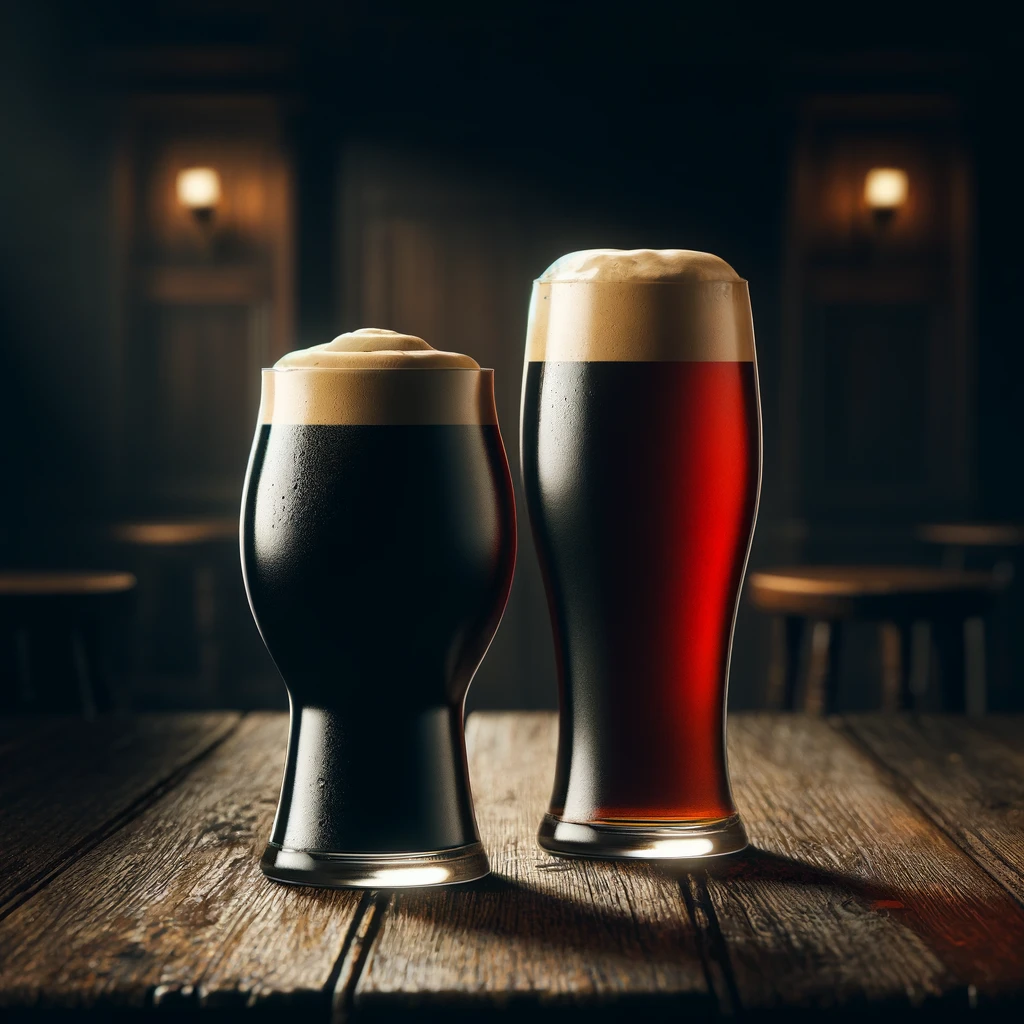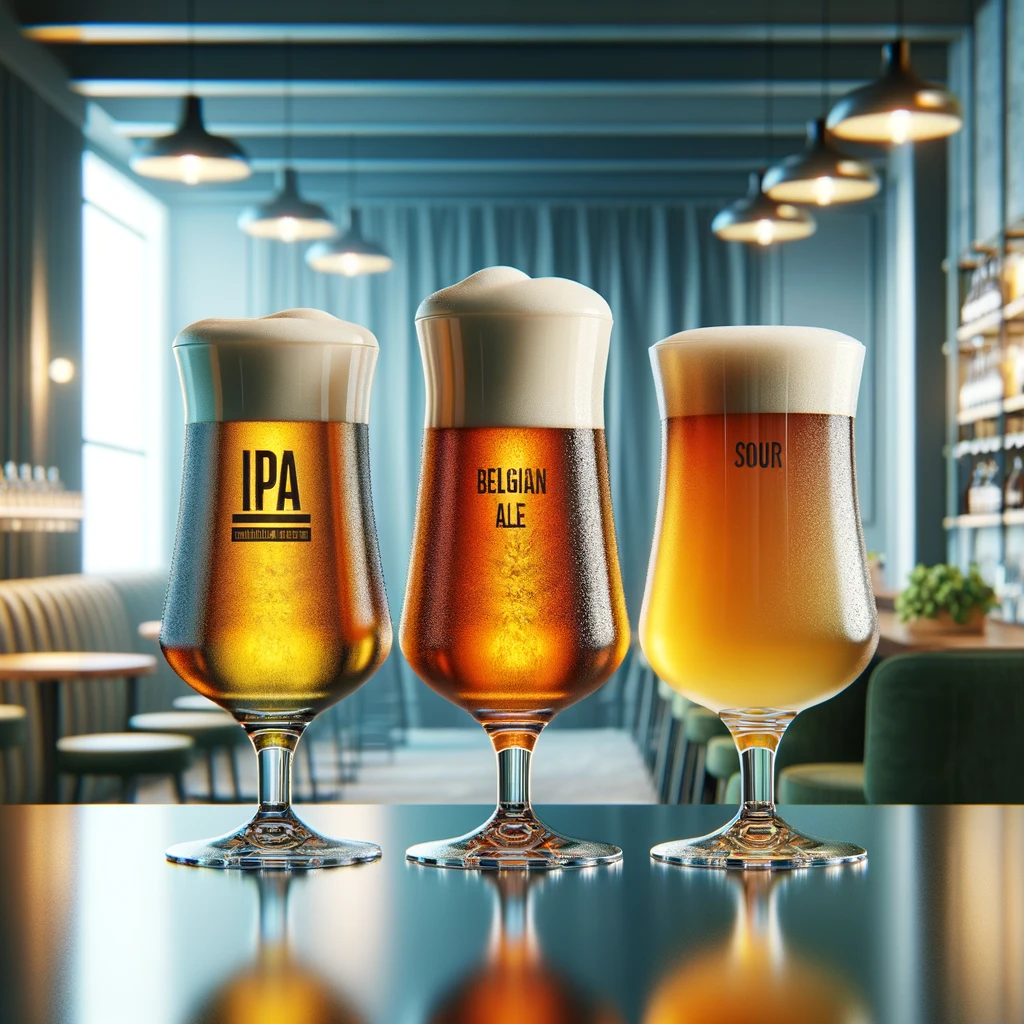Welcome to the comprehensive guide on beer styles, where we dive deep into the rich and diverse world of beers from crisp Pilsners to dark, robust Stouts. This guide is crafted to enlighten both novices and connoisseurs, detailing everything you need to know about various beer styles, their unique flavors, and how to choose the perfect beer for any occasion.
Understanding Beer Styles begins with recognizing the vast array of flavors, textures, and aromas that beers can offer. This guide aims to demystify the complex terminology and provide you with the knowledge to explore the beer world confidently.
Light Beers: Pilsners and Pale Ales

Exploring Pilsners
Pilsners are a type of lager that originated in the Czech Republic. These beers are known for their light golden color, crisp and refreshing taste, and slightly hoppy flavor. They are perfect for those new to the world of beers, offering a gentle introduction without overwhelming the palate.
- Origin: Czech Republic
- Color: Pale gold to light gold
- Clarity: Clear due to cold fermentation and longer conditioning
- Flavor: Crisp, refreshing with a balanced bitterness
- Aroma: Subtle malt with a touch of grassy or floral hops
- Alcohol Content: Generally between 4.5% and 6%
- Food Pairings: Seafood, light pastas, or spicy foods
- Serving Temperature: 38-45°F (3-7°C)
The Charm of Pale Ales
Pale Ales are popular among craft beer enthusiasts due to their balance of malt and hops. Originating from England, these ales are characterized by their amber hue and a more pronounced hop profile than Pilsners, yet they remain highly drinkable.
- Origin: England
- Color: Golden to deep amber
- Clarity: Generally clear
- Flavor: Balanced malt and hop flavors; hop bitterness is moderate
- Aroma: Malty, citrus, and floral hop aromas
- Alcohol Content: 4.5% to 5.5%
- Food Pairings: Burgers, fried foods, and spicy dishes
- Serving Temperature: 45-50°F (7-10°C)
Amber and Dark Ales: From Amber to Brown Ales

The Richness of Amber Ales
Amber Ales are known for their deep color and caramel flavor, often enriched by the use of roasted malts. They strike a delightful balance between the bitterness of hops and the sweetness of malts, making them a favorite during the cooler months.
- Origin: North America
- Color: Amber to deep red-brown
- Clarity: Clear to slightly hazy
- Flavor: Malt-forward with caramel sweetness, balanced with hop bitterness
- Aroma: Caramel, floral, and fruity
- Alcohol Content: 4.5% to 6%
- Food Pairings: Barbecued meats, pizzas, and hearty stews
- Serving Temperature: 45-50°F (7-10°C)
Delving into Brown Ales
Brown Ales vary from light to dark brown and are beloved for their notes of caramel, chocolate, and coffee. These beers blend malt sweetness with mild hop bitterness, creating a complex but smooth drinking experience.
- Origin: England
- Color: Dark amber to brown
- Clarity: Generally clear
- Flavor: Sweet malts, hints of caramel, chocolate, and coffee
- Aroma: Nutty and lightly hopped
- Alcohol Content: 4% to 6%
- Food Pairings: Roasted pork, smoked sausages, and grilled vegetables
- Serving Temperature: 45-50°F (7-10°C)
The World of Stouts and Porters

Discovering Stouts
Stouts are famous for their dark color and rich, creamy head. From dry Irish stouts to sweet milk stouts, these beers offer flavors ranging from coffee and chocolate to sweet lactose and oats. Stouts are perfect for savoring after dinner or on a cold day.
- Origin: England
- Color: Deep brown to black
- Clarity: Opaque
- Flavor: Roasted malts with notes of coffee, chocolate, and sometimes a hint of sweetness
- Aroma: Coffee, dark chocolate, and malty
- Alcohol Content: 4% to 12% ABV (varies widely across subtypes)
- Food Pairings: Oysters, chocolate desserts, and rich meats
- Serving Temperature: 50-55°F (10-13°C)
The Versatility of Porters
Porters, similar to stouts, are known for their dark appearance and chocolate and coffee notes. They are generally lighter in body than stouts, making them versatile for various culinary pairings, from grilled meats to rich desserts.
- Origin: England
- Color: Dark brown
- Clarity: Generally clear
- Flavor: Chocolate, coffee, and caramel, generally less bitter than stouts
- Aroma: Roasty with hints of chocolate and coffee
- Alcohol Content: 4% to 7% ABV
- Food Pairings: Smoked meats, chocolate desserts, and mild cheeses
- Serving Temperature: 45-50°F (7-10°C)
Specialty Beers: IPAs, Belgian Ales, and Sour Beers

The Popularity of IPAs
India Pale Ales (IPAs) have gained immense popularity, particularly in the American craft beer scene. Known for their strong hoppy bitterness, IPAs come in various styles, including West Coast IPAs, known for their pine and citrus notes, and New England IPAs, which are fruitier and hazier.
- Origin: England
- Color: Pale golden to reddish amber
- Clarity: Can be clear to hazy (especially New England IPAs)
- Flavor: Strong hop bitterness, citrus, pine, or floral flavors from hops
- Aroma: Hop-forward with citrus, pine, and floral notes
- Alcohol Content: 5.5% – 8.0% ABV
- Food Pairings: Spicy foods, grilled meats, and bold cheeses
- Serving Temperature: 45-50°F (7-10°C)
Belgian Beers
Belgian Ales are noted for their fruity and spicy flavors, often with a strong alcoholic punch.
- Origin: Belgium
- Color: Varies from pale to dark brown
- Clarity: Usually clear, some may be intentionally hazy
- Flavor: Complex, with fruity and spicy flavors; can be sweet or dry
- Aroma: Yeast-driven with fruity and spicy notes
- Alcohol Content: 6% to 12%
- Food Pairings: Mussels, fries, and strong cheeses
- Serving Temperature: 40-50°F (4-10°C)
Sour Beers
Sour Beers, on the other hand, offer a unique tartness that can range from subtly sour to intensely acidic, perfect for adventurous palates.
- Origin: Global (historical roots in Belgium)
- Color: Varies widely
- Clarity: Can be clear or hazy depending on the style
- Flavor: Distinctively tart, with varying degrees of sourness; may include fruity and earthy notes
- Aroma: Can range from nearly fruitless to strongly fruity, with earthy or barnyard undertones from wild yeast
- Alcohol Content: 3% to 8%
- Food Pairings: Light seafood dishes, fresh fruit, and soft cheeses like goat cheese
- Serving Temperature: 40-45°F (4-7°C)
Overview of International Pale Lagers
International Pale Lagers are typically lighter in color and taste, offering a clean and crisp drinking experience. They are widely appreciated for their versatility and approachability. Modelo Especial, a Mexican beer brewed by Grupo Modelo, falls into the category of International Pale Lagers. Known for their clean, crisp flavors and pale golden color, these beers are designed for wide appeal. Modelo Especial embodies this style perfectly, offering a highly drinkable experience with a mild hop presence and a balanced malt character.
Characteristics:
- Category: Pale Lager
- Color: Pale gold
- Flavor: Light and crisp with a subtle malt and hop balance
- Aroma: Mildly hoppy and slightly malty
- Alcohol Content: Usually around 4.4% to 4.7%
- Food Pairings: Works well with a variety of foods including light salads, chicken dishes, seafood, grilled dishes, Mexican food, or lighter fare
Example Beer:
- Modelo Especial: First brewed in 1925, Modelo Especial has become a popular choice for its straightforward, refreshing taste that pairs well with a variety of foods, reflecting its versatility and broad appeal.
Read more – Where is Modelo Beer Made?
Munich Dunkel-style Lagers: Modelo Negra
These lagers are known for their smooth malt flavor with notes of caramel, nuts, and sometimes chocolate, offering a darker and richer taste profile.
Modelo Negra
Modelo Negra, a Mexican beer brewed by Grupo Modelo, is categorized as a Munich Dunkel-style lager. It offers a smooth, rich taste with a deep amber to dark brown color and a clear appearance. The flavor profile features notes of sweet malt, caramel, and hints of chocolate, making it richer and darker than typical pale lagers. It also has a roasted malt and coffee aroma. While not as heavy or bitter as stouts or porters, Modelo Negra’s 5.3% ABV gives it a slightly stronger body compared to some pale lagers.
Characteristics:
- Category: Munich Dunkel-style Lager
- Color: Deep amber to dark brown
- Flavor: Rich malty flavors with caramel, nuts, and a hint of chocolate
- Aroma: Malty with sweet caramel notes
- Alcohol Content: Typically around 5.4%
- Food Pairings: Grilled meats, tacos, or spicy dishes.
Example Beers:
- Modelo Negra: This beer showcases the typical characteristics of the Munich Dunkel style, with its sweet, malty flavor accented by notes of caramel and a light hint of chocolate.
Belgian White Ales: Introduction to Witbier
Belgian White Ales, also known as “Witbier,” are refreshing, often spiced ales that are typically brewed with a significant proportion of wheat. This style is traditionally brewed with unfiltered methods, which leave the yeast and a portion of the wheat proteins in suspension, giving these beers a cloudy, white appearance. Common spices used in the brewing process include coriander and orange peel, which contribute to their distinctive citrusy and slightly spicy flavor profile.
Key Characteristics
- Color: Pale and cloudy due to the use of wheat and yeast
- Flavor: Lightly spiced, often with notes of coriander and citrus, particularly orange
- Aroma: Citrusy and spicy with noticeable yeast presence
- Alcohol Content: Generally between 4.5% and 5.5%
- Food Pairings: Ideal with seafood, chicken, and salads, or as a refreshing counterpart to spicy dishes
Example Beers:
- Hoegaarden: One of the most iconic examples of Witbier, Hoegaarden is lightly flavored with coriander and orange peel, offering a smooth and citrusy taste that’s both refreshing and slightly tart.
- St. Bernardus Wit: Known for its traditional approach, this beer offers a harmonious blend of fresh citrus flavor balanced with a soft, spicy character.
Pairing Beer with Food
Understanding how to pair beer with food can enhance both the beer and the meal. Light beers like Pilsners pair well with light dishes like salads or seafood, while darker beers like stouts match beautifully with hearty meals or chocolates.
FAQs on Beer Styles
Q: What is the difference between a stout and a porter?
A: While both stouts and porters are dark beers, the key difference lies in the flavor profiles and malt composition. Stouts generally have a more pronounced roasted flavor compared to porters, which tend to be milder and smoother.
Q: Can you recommend a beer for those who don’t typically enjoy beer?
A: For those new to beer or who prefer less bitterness, wheat beers or Belgian ales can be great choices. They offer lighter, often fruity and spicy flavors that might not be as overwhelming as more hop-heavy beers like IPAs.
Q: How should beer be stored before serving?
A: Beer should be stored upright in a cool, dark place to prevent light strike and to maintain optimal freshness. Keeping beer at a stable temperature is also crucial to preserve its flavors and quality.
Final Words
In conclusion, exploring understanding Beer Styles: From Pilsners to Stouts takes you on a journey through the diverse world of beers. Starting with the crisp Pilsners to the complex Pale Ales and onto the rich Stouts and Porters, each style offers its own unique flavors and experiences. This exploration isn’t just about tasting; it’s about appreciating the craftsmanship behind each brew.
Whether pairing light beers with delicate dishes or dark beers with hearty meals, understanding these styles enhances every drinking and dining experience. Embrace everything from Pale Ales to IPAs, and let your taste buds lead you through the innovative and traditional world of beer. Cheers to discovering the perfect brew for every palate and occasion!
Harold Desir is a seasoned beer enthusiast and expert, with over a decade of experience exploring the world of craft beers and brewing techniques. His deep knowledge of beer styles, brewing processes, and industry trends makes him a trusted voice in the beer community. Harold's passion for all things beer is evident in his engaging and informative blog posts, where he shares his insights, reviews, and tips with fellow beer lovers. Cheers!

